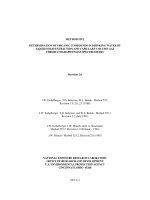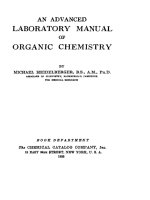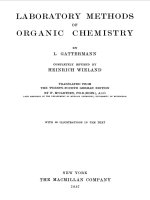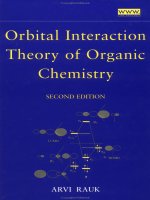Preview Basic Concepts of Organic Chemistry for Competitive Examinations by D.N. Singh (2010)
Bạn đang xem bản rút gọn của tài liệu. Xem và tải ngay bản đầy đủ của tài liệu tại đây (8.06 MB, 91 trang )
BASIC CONCEPTS OF
ORGANIC CHEMISTRY
D. N. Singh
(M.Sc., Ph.D)
Formerly, Reader in Chemistry
P.G.M.S. College, Motihari.
(B.R. Ambedkar Bihar University Muzaffarpur)
FM.indd i
8/18/2009 4:32:51 PM
Copyright © 2010 Dorling Kindersley (India) Pvt. Ltd.
Published by Pearson India Education Services Pvt. Ltd, CIN: U72200TN2005PTC057128,
formerly known as TutorVista Global Pvt. Ltd, licensee of Pearson Education in South Asia.
No part of this eBook may be used or reproduced in any manner whatsoever without the publisher’s
prior written consent.
This eBook may or may not include all assets that were part of the print version. The publisher
reserves the right to remove any material in this eBook at any time.
ISBN: 978-81-317-2809-3
eISBN
Head Office: 15th Floor, Tower-B, World Trade Tower, Plot No. 1, Block-C, Sector 16, Noida 201 301,
Uttar Pradesh, India.
Registered Office: 4th Floor, Software Block, Elnet Software City, TS-140, Block 2 & 9, Rajiv
Gandhi Salai, Taramani, Chennai 600 113, Tamil Nadu, India.
Fax: 080-30461003, Phone: 080-30461060
www.pearson.co.in, Email:
FM.indd ii
8/18/2009 4:32:51 PM
CONTENTS
Preface
1. Organic Chemistry
Classification of organic compounds
Hydrocarbons
Nomenclature
Tetravalency of carbon and structure
of organic compounds
2. Isomerism
Structural isomerism
Projection formulae
Stereoisomerism
Conformational isomerism
3. Electron Shift
1
2
3
10
23
36
36
43
45
59
71
Permanent polarization
Temporary polarization
71
71
4. Organic Acids and Bases
83
Bronsted–Lowry theory (1923)
Conjugate acid–base pair
Strength of acids
Simple carboxylic acids
Substituted acids
Dicarboxylic acids
Benzoic acid and its derivatives
Bases
5. Reaction Mechanism
Breaking of a covalent bond
Reagents
Reaction intermediates
Types of organic reactions
Addition to carbon–carbon multiple bonds
Addition of Br2 to C=C
Mechanism of addition
Aliphatic nucleophilic substitution
Factors affecting Sn reaction
The nature of the solvent
Elimination reactions
Direction of elimination
FM.indd iii
vii
83
83
84
88
89
90
91
95
106
106
107
108
125
127
128
128
138
144
149
151
157
Structural effects on direction
of eliminations
Dehalogenation
Competition between substitution
and elimination reactions
Reactions of –COOH group and its
derivatives
6. Name Reactions
Reimer–tiemann reaction
Cannizzaro reaction
Aldehydes without ␣-H atoms
Crossed cannizzaro reaction
Intramolecular cannizzaro reaction
Haloform reaction
Claisen condensation
Condensation of esters having only
one ␣-H atom
Crossed claisen condensation
Dieckmann reaction
Aldol condensation
Condensation of cyclic ketones
Intramolecular aldol condensation
Perkin reaction
Vinylogs of cinnamic acid
Kolbe reaction
Benzoin condensation
Wurtz–fittig reaction
Molecular rearrangements
Pinacol–pinacolone rearrangement
Demjanov rearrangement (expansion
and contraction of rings)
Hoffmann rearrangement or (hoffmann
bromamide reaction)
Fries rearrangement
Claisen rearrangement
Beckmann rearrangement
Benzilic acid rearrangement (migration to
carbonyl carbon)
159
160
161
161
174
174
175
176
176
177
178
180
181
182
182
184
187
188
189
190
190
191
192
193
197
200
201
202
204
206
207
7. Benzene
211
Naming
Nitration
212
220
8/18/2009 4:32:51 PM
iv
Contents
Alkylation
Halogenation
Deuteration
Arenes
Aryl halides
Aromatic sulphonic acids
Aromatic nitro compounds
Charge-transfer complexes
Aromatic amines
Phenols
Quinones
Aromatic aldehydes, ketones and acids
Aromatic ketones
Benzophenone (diphenyl ketone)
Aromatic carboxylic acids
8. Formation of Ring
Internal wurtz reaction
Ring compounds from dicarboxylic acids
Dieckmann cyclization
Internal aldol condensation and
cyclization
Acyloin condensation
Ring formation through
friedel–crafts acylation
Acid-catalysed cyclization
Diels–alder reaction and ring formation
Important points
Mechanisms
9. Alkanes
Isomers of pentane and hexane
Preparation
Properties and reactions
Melting points and boiling points of
straight-chain alkanes, CH3(CH2)n−2CH3
10. Alkenes
Isomerism in alkenes
Stability of alkenes
Preparation
Properties and reactions
Analytical tests of alkenes
11. Alkynes
Preparation
FM.indd iv
221
226
230
237
241
248
250
256
257
266
275
281
286
288
289
299
300
300
301
302
302
Higher alkynes
Properties
Chemical reaction
12. Aliphatic Halogen Compounds
Alkyl halides
13. Alcohols and Ethers
Classification
Distinction among 1°, 2° and
3° alcohols
Preparation of alcohols
Ethyl alcohol and methyl alcohol
Properties
Chemical reactions
Ethers
Preparation
Properties
Reactions
14. Aldehydes and Ketones
339
339
339
347
347
365
365
367
369
370
372
373
380
381
383
384
389
Aldehydes
Ketones
Properties and reactions
Reactions of >C=O group
Formation of alcohols
Aldehydes
Ketones
Characterization of aldehydes
and ketones
Distinction between aldehydes
and ketones
Ketenes
Dicarbonyl compound
Diketones
389
390
396
398
402
404
406
317
15. Carboxylic Acids and Derivatives
425
317
318
319
324
333
Preparation of carboxylic acids
Physical properties
Dissociation of carboxylic acids
Reactions of carboxylic acids
Physical properties
427
429
431
431
439
337
16. Organic Compounds of Nitrogen
450
303
303
303
304
305
306
307
308
311
312
337
Amines
414
415
417
418
419
450
8/18/2009 4:32:52 PM
Contents
17. Carbohydrates
Classification and nomenclature
Sugars and non-sugars
Reducing and non-reducing sugars
Ascending (or chain lengthening)
sugar series
Descending sugar series (chain
shortening)
Cellulose
18. Amino Acids, Proteins and Nucleic Acids
Configuration of natural amino acids
Nomenclature of amino acids
Essential and non-essential amino acids
Proteins
FM.indd v
468
469
471
471
479
480
493
497
497
498
498
504
19. Polymers
v
519
Polymers
Polyesters
Rubbers
Silk
Wool
Biodegradable polymers
519
529
534
536
536
536
20. Column Matching Problems
543
Column matching
543
21. Short Answer Problems
548
22. Problems on Structure Determination
555
8/18/2009 4:32:52 PM
This page is intentionally left blank.
FM.indd vi
8/18/2009 4:32:52 PM
Preface
This book is based on lectures prepared for students appearing in engineering and medical entrance examinations. It is also useful for those who have opted for the Chemistry (Honours) course. Although it is by no
means a comprehensive text, it covers the principles of the subject in a lucid manner to enable students to
understand easily.
Purpose of the Book
There are excellent books on organic chemistry easily available in the market. Prominent among these are
by Morrison and Boyd, Jerry March, Roberts and Caserio, Cram-Hammond, Finar and Pine. However, most
of the students do not find these text-books easy to use during the short period of their preparations. Keeping this in mind, the lectures were delivered to provide students with relevant standard materials of organic
chemistry.
Organization of the Book
The book has 22 chapters. Chapters 1–5 deal with the basic principles needed to understand organic chemistry. Chapter 6 is on name reactions. Chapter 7 is devoted to benzene, aromaticity and chemistry of benzene
derivatives. A separate chapter is given on ring formation. Chapters 9–16 discuss chemistry of different
functional groups. Chapter 17 is on carbohydrates, Chapter 18 is on amino acids, proteins and nucleic acids
and Chapter 19 is on organic polymers.
Problems are categorized into medium and complex levels, and these are given at the end of the book with
their solutions.
I thank the following people during the writing of this book:
• Several of my colleagues for their suggestions and feedback on the manuscript.
• My family members for providing encouragement.
• Mr Lalit Kumar Gupta for typing the entire manuscript.
I have tried my best to ensure that there are no errors in this book. However, suggestions for improving
the text are welcome.
Finally, I hope that those who read this book will utilize their knowledge carefully, honestly and responsibly for the benefit of all who come after.
D. N. Singh
FM.indd vii
8/18/2009 4:32:52 PM
This page is intentionally left blank.
FM.indd viii
8/18/2009 4:32:52 PM
CHAPTER
1
Organic Chemistry
The chemistry of carbon and hydrogen compounds, except CO2, CO, carbonates (COϪ2
) and bicarbonates
3
(HCOϪ
),
is
called
‘Organic
Chemistry’.
In
addition
to
C
and
H,
other
elements,
such
as
N,
O,
P, S and As, and
3
metals may also be present in an organic compound. The organic compounds containing metals are called
‘Organometallic Compounds’. They have M–C bond. For example, MeLi, Bu4Sn, RMgX and Et4Pb. Many
organometallic compounds have become important industrially, medicinally, etc. The number of organic
compounds far exceeds the total number of compounds formed by elements other than carbon. The vast
number of organic compounds is due to some special properties associated with carbon. They are
1. High catenation: The property of self-linking is called ‘Catenation’. It depends on the bond energy.
The C–C bond energy is high (~83kcal/mole); hence, carbon has high catenation property.
2. The ability of carbon to form variety of chains, i.e., straight and branched chains.
C
C
C
C
C
C
C
C
C
3. Carbon can also form ring compounds.
N
Chapter 01.indd 1
N
8/18/2009 9:55:21 PM
Basic Concepts of Organic Chemistry
2
4. Carbon can form multiple bonds with itself as well as with the heteroatoms (N, O, P, S, etc.).
C
C
C
,
N,
C
C
C
C
O,
C
,
C
C
C
S
,
The nature of bonds in the organic compounds is mainly covalent and the carbon in them is always tetravalent. It can achieve tetravalency in different ways. We will return to this topic later.
The produces of chemical technology (pesticides, herbicides, plastics, synthetic drugs, etc.) serve human
welfare to a large extent. However, it is now realized that our environment cannot accommodate all the products that are being added to it without decomposition. The grave consequences of a polluted environment can
only be avoided by wise application of the chemical knowledge.
CLASSIFICATION OF ORGANIC COMPOUNDS
The chemistry of organic compounds is most systematic and depends on the class of the compound. So,
classification of the organic compounds is the first step towards their study.
Carbon forms the basic skeleton of every organic compound. On this basis, the compounds are broadly
divided into two groups:
1. Aliphatic or open-chain compounds: In aliphatic compounds, carbon may form either straight or
branched chains. The word ‘Aliphatic’ is derived from the Greek word ‘Aliphos’ meaning fat. Some
of the compounds of this class were initially obtained from fat and so they were called aliphatic.
C
C
C
C
C
C
C
C
(Straight Chain)
CH3
CH2
CH2
(Branched Chain)
CH3
CH3
CH3
CH
CH3
(iso-Butane)
(n-Butane)
2. Cyclic or closed-chain compounds: In such compounds, carbon forms a ring. This class is further
divided into two groups:
(a) Carbocyclic or homocyclic: The compounds of this class contain only carbon atoms in the ring.
Carbocyclic compounds are further divided into two groups:
(i) Alicyclic compounds: Compounds of this class have properties similar to the aliphatic compounds.
H2
C
CH2
H2C
CH2
(Cyclopropane)
Chapter 01.indd 2
H2C
H2C
CH2
CH2
CH2
(Cyclohexane)
HC
HC
C
CH2
C
H2
(Cyclopentene)
8/18/2009 9:55:22 PM
Organic Chemistry
3
(ii) Aromatic compounds: The word ‘Aromatic’ is derived from the Greek word ‘Aroma’ meaning ‘Fragrant Smell’. Compounds of this class possess specific odour and so they are called
aromatic. The name is still in use. Aromatic compounds contain alternate single and double
bonds in their structure. It imparts special stability to such compounds that is termed as ‘Aromaticity’. We will return to this with some more details later.
H
C
HC
CH
HC
CH
C
H
(Benzene)
(Napthalene)
(b) Heterocyclic: The word ‘Hetero’ means different. Therefore, organic cyclic compounds containing
other polyvalent atoms (N, O, S, etc.) in the ring are called ‘Heterocyclic’ compounds.
N
O
S
N
H
(Pyrrole) (Furan) (Thiophene) (Pyridine)
N
(Tetrahydrofuran)
H
(Morpholine)
HYDROCARBONS
Organic compounds which contain only carbon and hydrogen are called ‘Hydrocarbons’. They are found
in nature in abundance in the form of petroleum, natural gas and coal. Hydrocarbons can be divided into
three main groups: open chain or aliphatic or acyclic hydrocarbons, alicyclic hydrocarbons and aromatic
hydrocarbons.
Acyclic Hydrocarbons
Acyclic hydrocarbons contain carbon atoms bonded together in the form of linear or branched chains. They
are of three types: alkanes, alkenes and alkynes.
Alkanes
The general formula of alkanes is CnH2n+2 where n = 1, 2, 3, etc. They are also called saturated hydrocarbons
or paraffins (paraffins from the word parum that means less and affins that means affinity). Alkanes contain
only single bond (or bond) between carbon and carbon. Carbon atoms may be present in the form of a linear
or a branched chain in alkanes.
Chapter 01.indd 3
8/18/2009 9:55:22 PM
Basic Concepts of Organic Chemistry
4
Types of chains The different types of chains are as follows:
1. Normal chain (n-chain): Alkanes in which carbon atoms are joined linearly are called normal-chain
hydrocarbons. In such alkanes, none of the carbon contains less than two hydrogen atoms or is joined
with more than two carbon atoms.
CH3–CH2–CH2–CH3
(n-butane)
CH3–CH2–CH2–CH2–CH3 (n-pentane)
2. Iso-chain: In iso-chain, carbon atom is joined with two methyl groups at either of the terminals.
iso
H3C
CH
H3C
CH3
CH2
CH
CH3 iso-Butane
CH3
CH3
iso
iso-Pentane
3. Neo-chain: A hydrocarbon chain in which one C atom is joined to three methyl groups is called a neo-chain.
CH3
CH3
C
CH3
neo-Pentane
CH2
CH3 neo-Hexane
CH3
CH3
CH3
C
CH3
neo
Nature of carbon atoms Four types of carbon atoms may be present in a chain.
1. Primary carbon (1º): The carbon that is joined with one carbon and three hydrogen atoms is called a
primary carbon.
2. Secondary carbon (2º): The carbon that is joined to two carbon atoms (and two hydrogen atoms) is
called a secondary carbon.
3. Tertiary carbon (3º): The carbon that is joined with three carbon atoms and one hydrogen atom is
called a tertiary carbon.
4. Quaternary carbon (4º): The carbon that is joined to four carbon atoms only is called a quaternary
carbon.
1°
CH3
1°
CH3
Chapter 01.indd 4
CH
3°
1°
CH3
1°
CH2 4°C CH3
2°
CH3
1°
8/18/2009 9:55:22 PM
Organic Chemistry
Alkyl groups
5
When an H atom is removed from an alkane, an alkyl group is formed.
Alkane-H = alkyl group
Alkyl groups are named by replacing ‘ane’ of the hydrocarbon by ‘yl’.
CH3
CH4 H
Methane
CH3
Methyl
CH3 H
Ethane
CH3 CH2
Ethyl
Thus, methane and ethane can form only one alkyl group each but propane (CH3–CH2–CH3) can produce
more than one alkyl group as hydrogen atoms are not all equivalent. Removing one of the six terminal
H-atoms forms n-propyl group, CH3–CH2–CH2– but removal of one of the two central hydrogrn atoms
produces the isopropyl group CH3 CH CH3.
Alkyl groups are classified as
1. Primary alkyl group (1º), if a C, having a free valency, is joined to only one C atom (and two H atoms)
C–CH2–.
2. Secondary alkyl group (2º), if a C, having a free valency, is joined to two C atoms (and one
H atom)
C
CH
C
3. Tertiary alkyl group (3º) if a C, having a free valency, is joined to three C atoms (and no H atom).
C
C C
C
The methyl group is a special case and is taken as a primary alkyl group. Alkyl groups are denoted by R–.
Alkenes
Alkenes are hydrocarbons, which have at least one C–C double bond. They have the general formula CnH2n.
They are also called olefins.
Table 1.1
Name
Chapter 01.indd 5
Molecular formula
Structure
Ethylene (ethene)
C2H4
H2C=CH2
Propylene (propene)
C3H6
CH3–CH=CH2
1-Butylene (1-butene)
C4H8
CH3–CH2–CH=CH2
2-Butylene (2-butene)
C4H8
CH3–CH=CH–CH3
8/18/2009 9:55:22 PM
Basic Concepts of Organic Chemistry
6
Alkenes having more than one double bonds are also known. They are:
1. Two double bonds – diene
2. Three double bonds – triene
3. Multiple double bonds – polyene
The location of each double bond is denoted by numbers.
Table 1.2
Name
Molecular formula
Structure
Propadiene (allene)
C3H4
H2C=C=CH2
1,3-Butadiene
C4H6
CH2=CH–CH=CH2
2-Methyl-1,3-butadiene (isoprene)
C4H8
H2C
C
CH
CH2
CH3
1,2,3-Butatriene
C4H4
CH2=C=C=CH3
The polyenes that have alternate single and double bonds are called conjugated polyenes (e.g. 1,3-butadiene).
Small-chain polyenes are colourless but long-chain polyenes are coloured. Carrot and tomato contain longchain polyenes that are coloured (yellowish) and are called ‘Carotene’.
Polyenes are further classified according to the position of the double bonds, one to the other.
1. Cumulated double bond: In this type of bond, the double bonds are continuous between the carbon
atoms.
C
C
C
For example, propadiene (allene),
CH2=C=CH2
2. Conjugated double bond: Substances having alternate single and double bonds are called conjugated
systems. Example, 1,3-butadiene.
CH2=CH–CH=CH2
3. Isolated double bonds: Compounds with double bonds that are neither cumulated nor conjugated are
said to have isolated double bond. Example, 1,4-pentadiene.
CH2=CH–CH2–CH=CH2
Alkenyl group Alkenyl group is formed when one of the hydrogen atoms of an alkene is removed. The
name of the alkenyl is obtained by replacing ‘e’ of alkene by ‘yl’.
Alkene − H = Alkenyl
Numbering of the chain starts at C atom that has free bond.
Chapter 01.indd 6
8/18/2009 9:55:23 PM
Organic Chemistry
7
Table 1.3
Alkenyl group
Structure
Ethenyl (vinyl)
CH2=CH–
1-Propenyl
CH3–CH=CH–
Allyl (2-propenyl)
CH2=CH–CH2–
Crotyl (2-butenyl)
CH3–CH=CH–CH2–
3-Butenyl
CH2=CH–CH2–CH2
1-Methyl ethenyl (isopropenyl)
CH3
CH2
C
Alkynes
Acyclic hydrocarbons that contain carbon–carbon triple bonds are called ‘alkynes’. Their general formula is
CnH2n−2. They are also called acetylenes.
Table 1.4
Alkyne
Molecular formula
Structure
Acetylene (ethyne)
C2H2
HC;CH
Propyne (methyl acetylene)
C3H4
CH3–C;CH
2-Butyne
C4H6
CH3–C;C–CH3
1,3 Butadiyne
C4H2
HC;C–C;CH
Many of the polyynes are found in plants. A few of them have been isolated.
Alkynyl group When a hydrogen atom is removed from an alkyne, the group formed is called an ‘alkynyl’
group. Here ‘e’ of alkyne is replaced by ‘yl’.
Ethynyl
H–C;C–
2-Propynyl (propargyl)
H–C;C–CH2–
Alicyclic Hydrocarbons
Alicyclic hydrocarbons (or cycloalkanes) contain ring of C atoms linked together by single bonds. They have
the general formula CnH2n. For example,
H2
C
H2C
CH2
Cyclopropane
or
Chapter 01.indd 7
H2C
CH2
H2C
CH2
Cyclobutane
or
H2
C
H2C
CH2
CH2
C
H2
(Cyclohexane)
or
H2C
8/18/2009 9:55:23 PM
8
Basic Concepts of Organic Chemistry
Cyclic hydrocarbons that contain carbon–carbon double and triple bonds are called cycloalkenes and cycloalkynes, respectively.
Cyclopentene
Cyclohexadiene
Cycloalkynes having less than seven C atoms are not known.
Cycloheptyne
Aromatic Hydrocarbons
Cyclic unsaturated hydrocarbons having conjugated double bonds are called aromatic hydrocarbons. They
are also called ‘arenes’. Benzene (C6H6) is the parent member (discovered by M. Faraday). Compounds of
this class possess characteristic smell. Thus, they were, and are, collectively called ‘aromatic’ (in Greek,
Aroma means fragrant smell).
Benzene
Naphthalene
CH3
Anthracene
CH3
Toluene
CH3
CH
CH
Isopropylbenzene
(Cumene)
CH2
Vinyl benzene
(Styrene)
The common aryl groups are
CH2
Phenyl
Benzyle
CH
Benzal
C
Benzo
β-Naphthyl
α-Naphthyl
(Details of the above are given in the chapter “Benzene.”)
Chapter 01.indd 8
8/18/2009 9:55:23 PM
Organic Chemistry
9
Functional group and classification
Many organic compounds contain two components. One component is the hydrocarbon, which mainly
controls the physical properties and the other called the ‘Functional Group’, mainly controls the chemical
properties.
H
H
C
OH
Functional group
H
In the above compound, –CH3 (methyl group) is the hydrocarbon and the –OH (hydroxyl group) is the
functional group. It controls the chemical properties and is called the ‘Alcoholic Functional Group’. Thus,
various combinations of atoms that control chemical properties of an organic compound are called ‘Functional
Groups’. Such groups are generated from heteroatoms (N, O, P, S, etc.). Compounds of a given class have the
same functional group and, hence, are chemically similar. The carbon–carbon double and triple bonds (C=C,
C;C) are also taken as functional groups.
Table 1.5
Class
Name of the functional group
Alkene
Double bond
Alkyne
Triple bond
Alkyl halide
Halide
Alcohol
Hydroxyl group
Ether
Ether group
Aldehyde
Aldehyde group or
formyl group
Ketone
Ketone group
Carboxylic acid
Carboxyl group
Formula of the functional group
C
H
C
O
R
H
O
R
H
C
H
C
H
C
C
CH3
Cl
CH3
OH
CH3
O
H
H
R
C
R
C
H
H3C
C
CH3
C
Acid chloride
CH3
C
Cl
O
H
OC2H5
O
O
C
O
O
O
OR
CH3
O
O
Carbalkoxy
H
H
H3C
C
H3C
O
O
H
H
O
O
C
C
Acid chloride
C
X
(X=F, Cl, Br, I)
C
Ester
C
Example
Cl
(Continued)
Chapter 01.indd 9
8/18/2009 9:55:23 PM
10
Basic Concepts of Organic Chemistry
Table 1.5 (Continued)
Class
Name of the functional group
Amide
Acid amide
Formula of the functional group
O
C
Acid anhydride
Anhydride
O
CH3
NH2
O
O
C
C
O
NH2
Primary amine
(1°)
Amine
Amino group
Example
N H
Secondary amine
(2°)
N
Tertiary amine
(3°)
O
Nitro
Nitro
N
Nitrito
Nitrito
O
N
Cyanide or nitrile
Cyano group or
nitrile group
C
N
O
O
C
NH2
O
O
CH3
C
CH3
NH2
H3C
N
H3C
O
C
CH3
H
H3C
H3C N
H3C
CH3
NO2
CH3
ONO
CH3
C
N
NOMENCLATURE
Trivial System
In this system, compounds were named on the basis of their origin. The trivial names are also called ‘Common
names’. Some examples of common names include:
1. Methyl alcohol [CH3–OH]: It was obtained by destructive distillation of wood and was called ‘Wood
Spirit’. From this, the name methyl alcohol was derived. (In Greek, Methu means wine and hule means
wood.)
2. Acetic acid: The chief constituent of vinegar derived its name from the Latin word Acetum meaning vinegar.
3. Formic acid: It was obtained by the distillation of red ants (in Greek, Formicus means red ants).
Many more may also be included but the great problem was that different names were given to a single compound. For example, CH4 was variously known as methane or marsh gas or fire-damp.
IUPAC system
Aliphatic compounds
The term IUPAC is the abbreviation of International Union of Pure and Applied Chemistry. This method of
naming considers saturated hydrocarbon as the parent compound. The other classes of organic compounds
Chapter 01.indd 10
8/18/2009 9:55:24 PM
Organic Chemistry
11
are taken as derivatives of the saturated hydrocarbons. Naming, according to this method, is a four-step
process:
1.
2.
3.
4.
Specification of root name.
Specification of primary suffix.
Specification of secondary suffix.
Specification of prefix (if there is a substituent).
Root name The longest C chain in the compound determines the root name. They are given in the table below.
Table 1.6
C chain
Root name
C chain
Root name
C
Meth
C6
Hex
C2
Eth
C7
Hept
C3
Prop
C8
Oct
C4
But
C9
Non
C5
Pent
C10
Dec
In general, the root name is ‘alk’.
Primary suffix The term suffix means ‘a group of letters added to the end of a word to make another word’.
Thus, primary suffix is the term which is added to the root name (alk) to show the saturated or unsaturated
nature of the C chain.
Table 1.7
Name of C chain
Saturated
C
Unsaturated
C
Primary suffix
Name
ane
Alkane
C
C
C
ene
Alkene
C
C
yne
Alkyne
Note:
1. If there is more than one double and triple bonds, then
two
C=C
diene
three
C=C
triene
three
C;C
triyne, etc.
2. Hydrocarbon radicals are named as
Table 1.8
Hydrocarbon
Chapter 01.indd 11
Primary suffix
Name
Alkane–H
yl
Alkyl
Alkene–H
enyl
Alkenyl
Alkyne–H
ynyl
Alkynyl
8/18/2009 9:55:24 PM
12
Basic Concepts of Organic Chemistry
Secondary suffix It represents the specific functional group. It is added after the primary suffix. It is the
class of the compound.
Table 1.9
Functional group
Secondary suffix
Hydroxyl group
–ol
Saturated or unsaturated (C=C)
–ol
Unsaturated (C=C)
–ol
Formyl or aldehyde
O
group
C
R
C
R
Ketonic group
–al
H
O
–one
Carboxyl group
O
(saturated or
unsaturated chain)
C
oic acid
OH
Acid chloride
O
(saturated or
unsaturated chain)
C
Ester group
C
oyl chloride
Cl
O
oate
OR
O
Amide group
C
amide
NH2
Cyanide group (–C;N)
nitrile
Ether group (–OR)
alkoxy
Nitro group (NH2)
nitro
Amino group (–NH2)
Primary amine
Class of the organic compound When root name, primary suffix and secondary suffix are added together,
class of the organic compound is obtained. The terminal ‘e’ of the primary suffix is generally removed before
adding secondary suffix.
Table 1.10
Trivial name
Root name
Primary suffix
Secondary suffix
IUPAC name
Alcohol
Alk
ane
ol
Alkanol
Unsaturated (C=C)
Alk
ene
ol
Alkenol
Unsaturated (C;C)
Alk
yne
ol
Alkynol
Aldehyde
Alk
ane
al
Alkanal
(Continued)
Chapter 01.indd 12
8/18/2009 9:55:24 PM
13
Organic Chemistry
Table 1.10 (Continued)
Trivial name
Root name
Primary suffix
Secondary suffix
IUPAC name
Ketone
Alk
ane
one
Alkanone
Carboxlic acid
Alk
ane
oic acid
Alkanoic acid
(C=C)
Alk
ene
oic acid
Alkenoic acid
(C;C)
Alk
yne
oic acid
Alkynoic acid
Ester
Alk
ane
oate
Alkyl alkanoate
Acid chloride
Alk
ane
oyl chloride
Akanoyl chloride
Acid amide
Alk
ane
amide
Alkanamide
Prefix In many organic compounds, H atom (or atoms) of the parent C chain are replaced by other groups.
Example, by –R or –Cl or –OH or –CN. They are called ‘Substituents’ (i.e., group of letters added to the
beginning of a word). For example, in
CH3
CH
CH2
OH
Cl
Root name = prop (as there are three C atoms)
Primary suffix = ane (as the compound is a derivative of a saturated C chain)
Secondary suffix = ol (as it has hydroxyl,
–OH group)
Prefix= chloro (as Cl has replaced H, i.e., Cl is a substituent)
Thus, the above compound is
2-chloropropan-1-ol
Steps to name simple compounds
1. The longest C chain is selected. If the compound contains a functional group, the longest chain must
include it (functional group).
2. The C chain is numbered.
3. Numbering starts from the end (left or right), which puts substituent or the functional group at the
lowest number.
4. If a functional group containscarbon, numbering starts from that C atom.
5. When many substituents are present, numbering starts from the end so that the sum of the locants (the
number which locates a substituent) is minimum.
(b)
CH3
CH3
1
4
2
3
5
6
CH3 CH CH CH2 CH CH3
6
5
4
3
2
1
CH3
(a)
(a) Sum of the locants = 2 + 3 + 5 = 10 (Correct)
(b) Sum of the locants = 2 + 4 + 5 = 11 (Wrong)
6. Each substituent (or a functional group) is denoted by putting a hyphen between the number and the
name of the substituent (or the functional group).
Chapter 01.indd 13
8/18/2009 9:55:25 PM
14
Basic Concepts of Organic Chemistry
CH3
C
C
C
2-Methyl
C
(substituent)
C
C
1-ene
(functional group)
7. Presence of more than one identical group is denoted by the Greek numeral.
two
di
three
tri
four
tetra
five
penta
six
hexa, etc.
8. When there are different substituents, their names are written in the alphabetical order.
1 2 3 4 5
C C C C C
3-Ethyl-2-methyl
CH3 C2H5
9. When different alkyl substituents are present at equivalent positions, numbering of the chain is done in
such a way that puts the alkyl group, which comes first in the alphabetical order, at the lower number.
CH3
1 2 3 4 5 6
C C C C C C
6 5 4 3 2 1
C2H5
(Wrong)
(Correct)
Note:
Greek letters (␣, , ␥, etc.) are also used to denote the position of a substituent. When the functional group
itself has carbon, the C atom adjacent to the functional group is ␣.
O
C
C
C
γ
β
α
C
H
When the functional group has no carbon, the functional group bearing the C atom is ␣.
C
C
C
γ
β
α
OH
The letter (omega) always represents the last C atom of a chain irrespective of its length.
Chapter 01.indd 14
8/18/2009 9:55:25 PM
Organic Chemistry
C
C
C
C
C
C
C
C
15
(Functional group)
ω
C
(Functional group)
ω
Examples
1.
CH3
CH3
N
CH3
C
2. CH3
CH2
CH2
CH3
O
CH3
O
CH3
Br
CH2
CH
CH3
HC
CH3
CH3
CH3
C CH2 CH CH3
4-Methylpent-1-yne
C
CH2
CH3
CH3
2,2-Dimethyl butane (neohexane)
CH3
3-Bromo-2-methyl pentane
7.
O
C
6.
CH
CH3
C C2H5
O
Ethanoic propanoic anhydride
C CH3
O
Ethanoic anhydride
CH3
O
4.
C
5.
CH2
N OH
Pent-3-one oxime
C2H5
3-Methyl-3-N,N-dimethyl pentane
3.
C
8.
CH3
CH3
CH2
CH
CH
CH3
CHO
2-Ethyl-3-methyl butanal
CH3
9.
CH3
C
CH2
Br
CH3
2,2-Dimethylbromopropane
(neopentyl bromide)
Naming of compounds having many functional groups
An organic compound may contain many functional groups. In such compounds, one functional group is the
principal functional group that decides the class of the compound (secondary suffix). The other functional
Chapter 01.indd 15
8/18/2009 9:55:25 PM
16
Basic Concepts of Organic Chemistry
groups are taken as substituents and are called prefixes. In selecting the principal functional group, an order of
preference is established (Table 1.11). It is
–SO3H > –COOH > acid anhydride > –COOR
> –COCl > –CONH2 > –CHO > –CN
|
> –CO (ketone) > –OH > –OR > C=C
> C≡C > –NO2 > –X (halogens)
Table 1.11
Functional group
Prefix name (substitutent)
Suffix name (class)
–SO3H
–
Sulphonic acid
–COOH
Carboxy
oic acid
–COOR
Carbalkoxy or
alkoxy carbonyl
Alkyl oate
–COCl
Chloro formyl or
chloro carbonyl
oyl chloride
–CONH2
Carbamoyl
Amide
–CHO
Formyl or aldo
al
–CN
Cyano
Nitrile
–NC
Isocyano
Carbylamine
>C=O
Oxo or keto
one
–OH
Hydroxy
ol
–NH2
Amino
Amine
–OR
Alkoxy
–
>C=C<
–
ene
–C;C–
–
yne
–NO2
Nitro
–
–NO
Nitroso
–
–X
Halo
Halo (chloro, bromo, etc.)
Steps in Naming
1. Principal functional group is decided using the preference table. It is the class of the compound.
2. The parent chain is selected in such a way that it includes the maximum number of substituents (here
the functional group is other than the principal functional group) and also the principal functional
group.
3. The chain is numbered so that the principal functional group falls at the lowest number.
4. Substituents are named in the alphabetical order.
5. Hydrocarbons with both double and triple bonds are called alkenynes (alkadienynes, alkenedynes,
etc.), i.e., the order ‘enyne’ is used. Numbering starts to put double bonds at the lower number.
Chapter 01.indd 16
8/18/2009 9:55:25 PM









